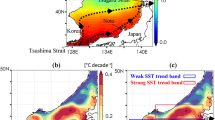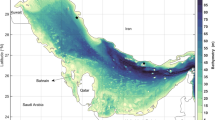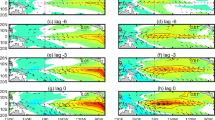Abstract
Estuarine salinity distributions reflect a dynamic balance between the processes that control estuarine circulation. At seasonal and longer time scales, freshwater inputs into estuaries represent the primary control on salinity distribution and estuarine circulation. El Niño-Southern Oscillation (ENSO) conditions influence seasonal rainfall and stream discharge patterns in the Tampa Bay, Florida region. The resulting variability in freshwater input to Tampa Bay influences its seasonal salinity distribution. During El Niño events, ENSO sea surface temperature anomalies (SSTAs) are significantly and inversely correlated with salinity in the bay during winter and spring. These patterns reflect the elevated rainfall over the drainage basin and the resulting elevated stream discharge and runoff, which depress salinity levels. Spatially, the correlations are strongest at the head of the bay, especially in bay sections with long residence times. During La Niña conditions, significant inverse correlations between ENSO SSTAs and salinity occur during spring. Dry conditions and depressed stream discharge characterize La Niña winters and springs, and the higher salinity levels during La Niña springs reflect the lower freshwater input levels.
Similar content being viewed by others
Literature Cited
Bendis, B. 1999. Water quality trends in Tampa Bay, Florida. M.S. Thesis, University of South Florida, Tampa, Florida.
Boler, R. N. 1998. Surface water quality: 1995–1997, Hillsborough Country, Florida. Environmental Protection Commission, Tampa, Florida.
Boler, R. N., R. C. Molloy, and E. M. Lesnett. 1991. Surface water quality monitoring by the environmental Protection Commission of Hillsborough County, p. 111–135.In S. Treat and P. Clark (eds.). Proceedings of the Tampa Bay Area Scientific Information Symposium 2. Tampa, Florida.
Boyer, J. N., J. W. Fourqurean, andR. D. Jones. 1997. Spatial characterization of water quality in Florida Bay and Whitewater Bay by multivariate analyses: Zones of similar influence.Estuaries 20:743–758.
Burwell, D. B. 2001. Modeling residence times: Eulerian vs. Langriangian. Ph.D. Dissertation, University of South Florida, Tampa, Florida.
Coastal Environmental/PBS&J, Inc. 1998. Cumulative Impact analysis for Master Water Plan Projects. Final Report prepared for the West Coast Regional Water Supply Authority, Clearwater, Florida.
Dawson, A. G. andG. O’Hare. 2000. Ocean-atmosphere circulation and global climate: The El Niño-Southern Oscillation.Geography 85:193–208.
DelCharco, M. J. 1998. Tidal flow in Selected Areas of Tampa Bay and Charlotte Harbor, Florida, 1995–1996. U.S. Geological Survey Water-Resources Investigations Report 97-4265. Tallahassee, Florida.
Flannery, M. S. 1989. Tampa and Sarasota Bays’ watersheds and tributaries, p. 18–48.In E. D. Estevez (ed.) NOAA Estuary-of-the-Month, Seminar Series No. 11. U.S. Department of Commerce, national Oceanic and Atmospheric Administration, Estuarine Programs Office, Washington D.C.
Galperin, B., A. F. Blumberg, and R. H. Weisberg. 1991. A time-dependent three-dimensional model of circulation in Tampa Bay, p. 77–98.In S. Treat and P. Clark (eds.). Proceedings of the Tampa Bay Area Scientific Information Symposium 2. Tampa, Florida.
Goodwin, C. R. and D. M. Michaelis. 1976. Tides in Tampa Bay, Florida: June 1971 to December 1973. United States Geological Survey Open File Report FL75004. Tallahassee, Florida.
Harwell, M. A., J. S. Ault, andJ. H. Gentile. 1995. Comparison of the Ecological Risks to the Tampa Bay Ecosystem from Spills of Fuel Oil #6 and Orimulsion. Comparative Ecological Risk Assessment, Volume 1. Center for Marine and Environmental Analyses, University of Miami, Miami, Florida.
Hoerling, M. P., A. Kumar, andM. Zhong. 1997. El Niño, La Niña, and the nonlinearity of their teleconnections.Journal of Climate 10:1769–1786.
lewis, III, R. R. and R. L. Whitman, Jr. 1985. A new geographic description of the boundaries and subdivisions of Tampa Bay, p. 10–18.In S. F. Treat, J. L. Simon, R. R. Lewis, III, and R. L. Whitman, Jr. (eds.), Proceedings of the Tampa Bay Area Scientific Information Symposium. Tampa, Florida.
Lipp, E. K., R. Kurz, R. Vincent, C. Rodriquez-Palacios, S. R. Farrah, andJ. B. Rose. 2001a. The effects of seasonal variability and weather on microbial fecal pollution and enteric pathogens in a subtropical estuary.Estuaries 24:266–276.
Lipp, E. K., N. Schmidt, M. E. Luther, andJ. B. Rose. 2001b. Determining the effect of El Niño-Southern Oscillation events on coastal water quality.Estuaries 24:491–497.
Noreen, E. W. 1989. Computer Intensive Methods for Testing Hypotheses. John Wiley and Sons, New York.
Peebles, E. 1999. An Assessment of the Effects of Freshwater Inflows on Fish and Invertebrate Habitat Use in the Manatee River, Braden River, Peace River, and Shell Creek Estuaries, Volume I: Monthly Monitoring. Report prepared for Southwest Florida Water Management. Tampa, Florida.
Pritchard, D. W. 1956. The dynamic structure of a coastal plain estuary.Journal of Marine Research 15:33–42.
Rasmusson, E. M. andT. H. Carpenter. 1982. Variations in tropical sea surface temperature and surface wind fields associated with the Southern Oscillation/El Niño.Monthly Weather Review 110:354–384.
Rasmusson, E. M. andJ. M. Wallace. 1983. Meteorological aspects of the El Niño/Southern Oscillation.Science 222:195–202.
Ropelewski, C. F. andM. S. Halpert. 1986. North American precipitation and temperature patterns associated with the El Niño Southern Oscillation (ENSO).Monthly Weather Review 114:352–362.
Rutherford, E. H., B. J. Bendis, G. A. Vargo, andK. A. Fanning. 1995. Review of historical Tampa Bay water quality data.Florida Scientist 58:67–81.
Schmidt, N., E. K. Lipp, J. R. Rose, andM. E. Luther. 2001. ENSO influences on seasonal rainfall and river discharge of Florida.Journal of Climate 42:615–628.
Southwest Florida Water Management District (SWFWMD). 1998. Comprehensive Watershed Management Plant. Tampa Bay/Anclote River, Volume I: Assessment. Tampa. Florida.
Squires, A. P., G. A. Vargo, R. H. Weisberg, K. A. Fanning, andB. Galperin. 1995. Review and synthesis of historical Tampa Bay water quality data.Florida Scientist 58:228–233.
Tampa Bay National Estuary Program (TBNEP). 1995. Current and historical freshwater inflows to Tampa Bay, Florida. Technical Publication #01-94. St. Petersburg, Florida.
Tampa Bay Water. 2000. New Water Plan. Quarterly Report. September 2000, prepared for the Southwest Florida Water Management District. Clearwater, Florida.
Trenberth, K. E. 1991. General characteristics of El Niño-Southern Oscillation, p. 13–42.In M. H. Glantz, R. W. Kantz and N. Nicholls, (eds.) Teleconnections Linkings Worldwide Climate Anomalies. Cambridge University Press, New York.
Winsberg, M. D. 1990. Florida Weather. University of Central Florida Press, Orlando, Florida.
Zarbock, H., A. Janicki, D. Wade, D. Heimbuch, andH. Wilson. 1995. Current and Historical Freshwater Inflows to Tampa Bay. Tampa Bay National Estuary Program, St. Petersburg, Florida.
Zervas, C. E. (ed.). 1993. Tampa Bay Oceanography Project: Physical Oceanographic Synthesis. NOAA Technical Report NOS OES 002. Department of Commerce, National Oceanic and Atmospheric Administration, National Ocean Service. Silver Springs, Maryland.
Zhang, M. 1994. Predictability of sea level and currents of Tampa Bay. M.S. Thesis, University of South Florida, St. Petersburg, Florida.
Sources of Unpublished Materials
Matheson, Jr., R. E. unpublished data. Florida Fish and Wildlife Conservation Commission, Florida Marine Research Institute. 100 8th Avenue SE, St. Petersburg, Florida 33701.
National Oceanic and Atmospheric Administration (NOAA). 1998. Population: Distribution, density and growth. NOAA’s State of the Coast Report. URL: http://state_of_coast.noaa.gov/bulletin/html/pop_01/pop.html
Author information
Authors and Affiliations
Corresponding author
Rights and permissions
About this article
Cite this article
Schmidt, N., Luther, M.E. ENSO impacts on salinity in Tampa Bay, Florida. Estuaries 25, 976–984 (2002). https://doi.org/10.1007/BF02691345
Received:
Accepted:
Issue Date:
DOI: https://doi.org/10.1007/BF02691345




